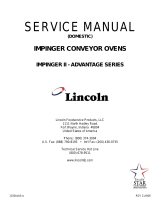
TABLE OF CONTENTS
SEQUENCE OFOPERATIONS 1104 THRU 1106...................................................... 3-4
SEQUENCE OF OPERATIONS 1134, 1135, 1136, 1150........................................... 5-6
SEQUENCE OF OPERATIONS 1151....................................................................... 7-8
SEQUENCE OF OPERATIONS 1152 THRU 1158.................................................... 9-11
SCHEMATIC 1104, 1105......................................................................................... 12
SCHEMATIC 1106 ................................................................................................. 13
SCHEMATIC 1134, 1135, 1150 S/N 2011383 & BELOW.......................................... 14
SCHEMATIC 1134, 1135, S/N 2011383 & ABOVE................................................... 15
SCHEMATIC 1150 S/N 2011373 & ABOVE.............................................................. 16
SCHEMATIC 1136, S/N 2011383 & ABOVE............................................................. 17
SCHEMATIC 1136, S/N 20211383 & ABOVE........................................................... 18
SCHEMATIC 1151, S/N 2011383 & BELOW............................................................ 19
SCHEMATIC 1151, S/N 2011373 & ABOVE............................................................ 20
SCHEMATIC 1152 THRU 1158, S/N 2011383 & BELOW......................................... 21
SCHEMATIC 1152 THRU 1158, S/N 2011383 & ABOVE.......................................... 22
SCHEMATIC 1152 & 1153 S/N 2011821 & ABOVE.................................................. 23
SCHEMATIC 1154 THRU 1158, S/N 2011821 & ABOVE.......................................... 24
TROUBLE SHOOTING GUIDE, GAS OVENS 1152 THRU 1158.............................. 25-33
TROUBLE SHOOTING GUIDE, ELECTRIC OVENS 1104, 1105, 1106..................... 34-36
TROUBLE SHOOTING GUIDE, ELECTRIC OVENS 1134, 1135, 1136, 1150........... 37-40
TROUBLE SHOOTING GUIDE, ELECTRIC OVEN 1151......................................... 41-46
REMOVAL, INSTALLATION, AND ADJUSTMENTS................................................. 47-69
GENERAL, PARTS BREAKDOWN.......................................................................... 70
GENERAL, PARTS BLOW UP................................................................................. 71
CONTROL COMPARTMENT FRONT, PARTS BREAKDOWN.................................. 72
CONTROL COMPARTMENT FRONT, BLOW UP..................................................... 73
CONTROL COMPARTMENT FRONT, 1152 THRU 1158 PARTS BREAKDOWN....... 74
CONTROL COMPARTMENT FRONT, 1152 THRU 1158 BLOW UP......................... 75
CONTROL COMPARTMENT REAR, S/N 2011383 & BELOW PARTS..................... 76
CONTROL COMPARTMENT REAR, S/N 2011383 & BELOW BLOW UP................. 77
CONTROL COMPARTMENT REAR, S/N 2011383 & ABOVE PARTS...................... 78
CONTROL COMPARTMENT REAR, S/N 2011383 & ABOVE BLOW UP................. 79
CONTROL COMPARTMENT REAR, 1152 THRU 1158, S/N 2011821 & BELOW
PARTS BREAKDOWN................................................................................ 80
CONTROL COMPARTMENT REAR, 1152 THRU 1158, S/N2011821 & BELOW
BLOW UP...................................................................................................... 81
CONTROL COMPARTMENT REAR, 1152 THRU 1158, S/N 2011821 & ABOVE
PARTS BREAKDOWN................................................................................. 82
CONTROL COMPARTMENT REAR, 1152 THRU 1158, S/N2011821 & ABOVE
BLOW UP...................................................................................................... 83
OVEN BACK ASSEMBLY PARTS BREAKDOWN.................................................... 84
OVEN BACK ASSEMBLY BLOW UP...................................................................... 85
GEARMOTOR ASSEMBLY PARTS BREAKDOWN................................................. 86
GEARMOTOR ASSEMBLY BLOW UP.................................................................... 87
CONVEYOR / DOOR PARTS BREAKDOWN......................................................... 88
CONVEYOR / DOOR BLOW UP.............................................................................. 89
Impinger II - 1100 Series Service Manual - International2

























